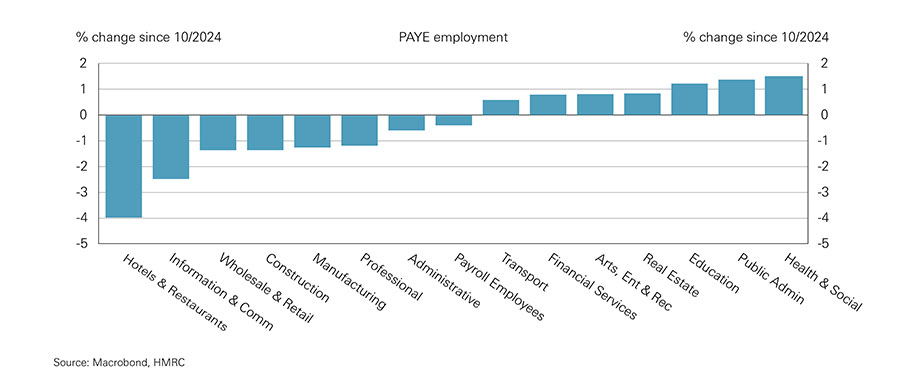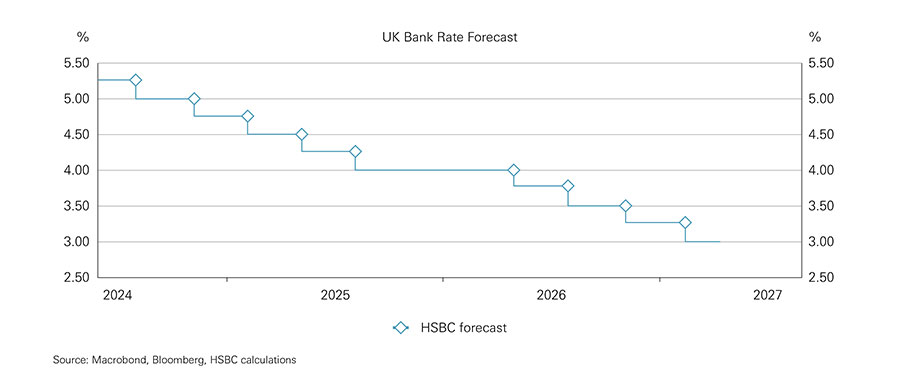- 3 minutes
- Article

- Support
- Economic Reports
- Market Research
UK in Focus: Essential economic news for businesses
There was weakness across a broad range of indicators in September as existing challenges combine with near-term uncertainty. Meanwhile there was a lack of disinflation, putting the BoE’s interest rate cuts on hold until Spring 2026.
Are we at peak UK pessimism yet?
September was a challenging month for the UK economy. Economic activity took a disappointing turn with the composite output PMI falling into contractionary territory, for its second time this year. Moreover, despite an overall pick-up in the PMIs in the third quarter relative to Q2, official data for July showed zero growth on the month.
Businesses are operating in a challenging environment with tailwinds now meeting headwinds. It’s perhaps no surprise, then, that business confidence has fallen back, and spend and investment decisions appear to be in ‘wait-and-see’ mode, possibly until after the Autumn Budget when the Chancellor is expected to tighten policy by cGBP30bn by 2029/30 (FT, 2 October 2025). Similarly, consumer confidence was weak with households nervous about the past and future ‘economic situation’.
Disinflationary forces have taken a break
Meanwhile, price growth likely peaked in September – we forecast a 4.2% y-o-y CPI rate – up from 3.8% reported in August. In particular, food price growth was at its highest since January 2024 while the moderation in services price growth has stalled in recent months. Both are of concern due to their knock-on impact into inflation expectations and broader wage and price setting behaviour. Indeed with medium-term inflation expectations at 4% and real incomes, at best, on par with three years ago, there is a risk that a degree of ‘real wage resistance’ becomes evident in 2026, whereby households aim to offset the recent rise in the cost of living.
That upside risk to inflation is possible against a backdrop of a stabilisation in labour demand. Notwithstanding elevated unit labour cost growth, outright falls in headcount appear to have been concentrated in sectors most exposed to higher labour costs while overall employment is just 0.4% lower than October 2024.
Positively, the absence of outright labour market weakness puts the UK in a good position for a potential pick-up in activity, if near-term risks subside. However, we expect employment growth to remain soft while improved labour supply pushes the unemployment rate higher; helping to moderate wage growth and return inflation to target in 2027.
In policy terms, we expect Bank Rate to be held at 4.00% until the Spring, when the BoE should have greater certainty that these risks have subsided and further disinflation is evident. From April 2026, we expect rate cuts to resume their “gradual and careful” path of one-cut-per-quarter.
Download a PDF version of the report
Analyst Certification
The following analyst(s), economist(s), or strategist(s) who is(are) primarily responsible for this report, including any analyst(s) whose name(s) appear(s) as author of an individual section or sections of the report and any analyst(s) named as the covering analyst(s) of a subsidiary company in a sum-of-the-parts valuation certifies(y) that the opinion(s) on the subject security(ies) or issuer(s), any views or forecasts expressed in the section(s) of which such individual(s)is(are) named as author(s), and any other views or forecasts expressed herein, including any views expressed on the back page of the research report, accurately reflect their personal view(s) and that no part of their compensation was, is or will be directly or indirectly related to the specific recommendation(s) or views contained in this research report: Emma Wilks.
Important disclosures
This document has been prepared and is being distributed by the Research Department of HSBC and is intended solely for the clients of HSBC and is not for publication to other persons, whether through the press or by other means.
This document is for information purposes only and it should not be regarded as an offer to sell or as a solicitation of an offer to buy the securities or other investment products mentioned in it and/or to participate in any trading strategy. Advice in this document is general and should not be construed as personal advice, given it has been prepared without taking account of the objectives, financial situation or needs of any particular investor. Accordingly, investors should, before acting on the advice, consider the appropriateness of the advice, having regard to their objectives, financial situation and needs. If necessary, seek professional investment and tax advice.
Certain investment products mentioned in this document may not be eligible for sale in some states or countries, and they may not be suitable for all types of investors. Investors should consult with their HSBC representative regarding the suitability of the investment products mentioned in this document and take into account their specific investment objectives, financial situation or particular needs before making a commitment to purchase investment products.
The value of and the income produced by the investment products mentioned in this document may fluctuate, so that an investor may get back less than originally invested. Certain high-volatility investments can be subject to sudden and large falls in value that could equal or exceed the amount invested. Value and income from investment products may be adversely affected by exchange rates, interest rates, or other factors. Past performance of a particular investment product is not indicative of future results.
HSBC and its affiliates will from time to time sell to and buy from customers the securities/instruments, both equity and debt (including derivatives) of companies covered in HSBC Research on a principal or agency basis or act as a market maker or liquidity provider in the securities/instruments mentioned in this report.
Analysts, economists, and strategists are paid in part by reference to the profitability of HSBC which includes investment banking, sales & trading, and principal trading revenues.
Whether, or in what time frame, an update of this analysis will be published is not determined in advance.
For disclosures in respect of any company mentioned in this report, please see the most recently published report on that company available at www.hsbcnet.com/research. HSBC Private Banking clients should contact their Relationship Manager for queries regarding other research reports. In order to find out more about the proprietary models used to produce this report, please contact the authoring analyst.
- This report is dated as at 06 October 2025.
- All market data included in this report are dated as at close 06 October 2025, unless a different date and/or a specific time of day is indicated in the report.
- HSBC has procedures in place to identify and manage any potential conflicts of interest that arise in connection with its Research business. HSBC's analysts and its other staff who are involved in the preparation and dissemination of
Research operate and have a management reporting line independent of HSBC's Investment Banking business. Information Barrier procedures are in place between the Investment Banking, Principal Trading, and Research businesses
to ensure that any confidential and/or price sensitive information is handled in an appropriate manner. - You are not permitted to use, for reference, any data in this document for the purpose of (i) determining the interest payable, or other sums due, under loan agreements or under other financial contracts or instruments, (ii) determining the price at which a financial instrument may be bought or sold or traded or redeemed, or the value of a financial instrument, and/or (iii) measuring the performance of a financial instrument or of an investment fund





